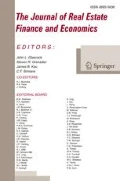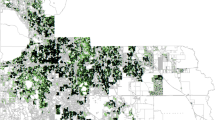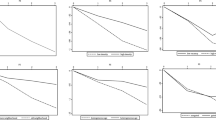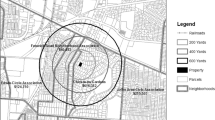Abstract
Previous studies have shown that foreclosure often results in vandalism, disinvestment and other negative spillover effects in the neighborhood. This paper extends these views into a formal theoretical model through pricing based on comparables. We project that the spillover effect of a foreclosure on neighborhood property values depends on two factors: the discount of foreclosure sale and the weight placed on the foreclosed property as a comparable in the valuation. The former is related to housing cycle and the latter varies by time of foreclosure and its distance from the subject property. Empirical results based on a 2006 sample show that this effect is significant within a radius of 0.9 km (roughly 10 blocks) and within 5 years from its liquidation. The most severe impact is an 8.7% discount on neighborhood property values, which gradually drops to anywhere between −1.2 to −1.7% for foreclosures liquidated within the past 5 years. These spillover effects vary slightly when the sample selection bias is taken into account. Based on an alternative sample of purchase transactions in 2003, the estimated spillover effects in booming years are reduced by half, confirming on the important role played by housing cycles.








Similar content being viewed by others
Notes
Immergluck and Smith (2005) and Nassar (2007) both found that spatial concentration of subprime lending has led to concentrations of foreclosures in minority and modest-income neighborhoods, which is the emphasis of affordable housing goal. Recent home price depreciation or moderation has largely dampened the standing of this population.
See Appendix for the “derivation” of the hypothesis.
Data source: National Association of Realtors.
References
Baxter, V., & Lauria, M. (2000). Residential Mortgage Foreclosure and Neighborhood Change. Housing Policy Debate, 11, 675–699.
Cannon, S., Norman, G. M., & Gurupdesh S. P. (2006). Risk and Return in the U.S. Housing Market: A Cross-sectional Asset-Pricing Approach. Real Estate Economics, 34(4), 519–552.
Collins, M. (2003). Chicago’s Homeownership Preservation Challenge: Foreclosures, Mimeo, Joint Center for Housing Studies, Harvard University.
Cutts, A. C., & Green R. K. (2004). Innovative Servicing Technology: Smart Enough to Keep People in Their Houses? Freddie Mac Working Paper No. 04–03. Washington, DC: Freddie Mac. World Wide Web page <http://www.freddiemac.com/news/pdf/fmwp_0403_servicing.pdf> (accessed April 20, 2007).
Deng, Y., Pavlov, A. D., & Yang, L. (2005). Spatial Heterogeneity in Mortgage Terminations by Refinance, Sale and Default. Real Estate Economics, 33(4), 739–764.
Deng, Y., Quigley, J. M., & Van Order, R. (2000). Mortgage Terminations, Heterogeneity and the Exercise of Mortgage Options. Econometrica, 68(2), 275–307.
Focardi, C. (2002). Servicing Default Management: An Overview of the Process and Underlying Technology. TowerGroup Research Note, No. 033-13C (November 15, 2002).
Forgey, F., Rutherford, R., & VanBuskirk, M. (1994). Effect of Foreclosure Status on Residential Selling Price. Journal of Real Estate Research, 9, 313–318.
Goldstein, I., Maggie, M., Al, P., & Daniel, U.-A. (2005). Mortgage Foreclosure Filings in Pennsylvania. Philadelphia: Reinvestment Fund. World Wide Web page <http://www.trfund.com/policy/PA_Foreclosures.htm> (accessed April 22, 2007).
Goodman, J. L. (1992). A Housing Market Matching Model of the Seasonality in Geographic Mobility. Journal of the Real Estate Research, 8(1), 117–137.
Goodman, A. C., & Thibodeau, T. G. (1997). Dwelling-Age-Related Heteroskedasticity in Hedonic House Price Equations: An Extension. Journal of Housing Research, 8(2), 299–317.
Halverson, R., & Palmquist, R. (1980). The Interpretation of Dummy Variables in Semilogarithmic Regressions. American Economic Review, 70, 474–475.
Hardin, W., & Wolverton, M. (1996). The Relationship between Foreclosure Status and Apartment Price. Journal of Real Estate Research, 12, 101–109.
Heckman, J. (1979). Sample Selection Bias as a Specification Error. Econometrica, 47(1), 153–161.
Immergluck, D., & Smith, G. (2005). Measuring the Effects of Subprime Lending on Neighborhood Foreclosures: Evidence from Chicago. Urban Affairs Review, 40, 362–389.
Immergluck, D., & Smith, G. (2006). The External Costs of Foreclosure: The Impact of Single-Family Mortgage Foreclosures on Property Values. Housing Policy Debate, 17, 57–79.
Lancaster, K. J. (1966). A New Approach to Consumer Theory. Journal of Political Economy, 74, 132–157.
Lacour-Little, M. (2000). The Evolving Role of Technology in Mortgage Finance. Journal of Housing Research, 11(2), 173–205.
Lin, Z., & Liu, Y. (2007). Real Estate Return and Risk with Heterogeneous Investors. forthcoming in Real Estate Economics.
Lin, Z., & Vandell, K. (2007). Illiquidity and Pricing Biases in the Real Estate Market. Real Estate Economics, 35, 291–330.
McCarthy, G., VanZandt, S., & Rohe, W. (2001). The Economic Benefits and Costs of Homeownership: A Critical Assessment of the Research. Working Paper 01–02. Washington, DC: Research Institute for Housing America.
Moreno, A. (1995). The Cost-Effectiveness of Mortgage Foreclosure Prevention. Minneapolis: Family Housing Fund.
National Association of Realtors, Research Division. (2004). Rising Foreclosure Rates in Indiana: An Explanatory Analysis of Contributing Factors. World Wide Web page <http://www.mibor.com/_pdfs/ForeclosureStudy2004.pdf > (accessed April 16, 2007).
National Training and Information Center. (1999). Preying on Neighborhoods: Subprime Mortgage Lenders and Chicagoland Foreclosures. Chicago.
Rosen, S. (1974). Hedonic Prices and IMPLICIT Markets: Product Differentiation in Pure Competition. Journal of Political Economy, 82(1), 34–55.
Simons, R. A., Quercia, R. G., & Maric, I. (1998). The Value of Residential Construction and Neighborhood Disinvestment in Residential Sales Price. Journal of Real Estate Research, 15(1/2), 147–161.
Vandell, K. D. (1991). Optimal Comparable Selection and Weighting in Real Property Valuation. ARERUEA Journal, 19(2), 213–239.
Vandell, K. D. (1995). How Ruthless Is Mortgage Default? A Review and Synthesis of the Evidence. Journal of Housing Research, 6(2), 245–264.
Author information
Authors and Affiliations
Corresponding author
Additional information
We wish to thank editor C.F. Sirmans, an anonymous referee at the Journal of Real Estate Finance and Economics, and Paul Obrecht at Fannie Mae for their insightful comments and suggestions. All errors remain our own. The views expressed in this article are our own and do not necessarily represent the views of Fannie Mae. This article won a best research paper from the American Real Estate Society Foundation in 2007.
Appendix
Appendix
“Derivation” of the Hypothesis
The adjusted sale price based on each comparable sale price (i) is determined as follows,
Thus, the final value estimate of the subject property can be computed as
The optimization problem for choosing weights and the number of comparable properties can be expressed as
When \( \operatorname{cov} {\left( {\widehat{P}_{{i,subject}} - P_{{subject}} ,\widehat{P}_{{k,subject}} - P_{{subject}} } \right)} = 0 \) for i ≠ k, then Eq. A.3 can be further simplified as,
where
Generally speaking, the variance in Eq. A.4, \( \sigma ^{2}_{i} \), should increase with time and distance. We can thus hypothesize:
Thus, we can expect that
From Eq. 6, we thus have
and,
Rights and permissions
About this article
Cite this article
Lin, Z., Rosenblatt, E. & Yao, V.W. Spillover Effects of Foreclosures on Neighborhood Property Values. J Real Estate Finan Econ 38, 387–407 (2009). https://doi.org/10.1007/s11146-007-9093-z
Received:
Accepted:
Published:
Issue Date:
DOI: https://doi.org/10.1007/s11146-007-9093-z




